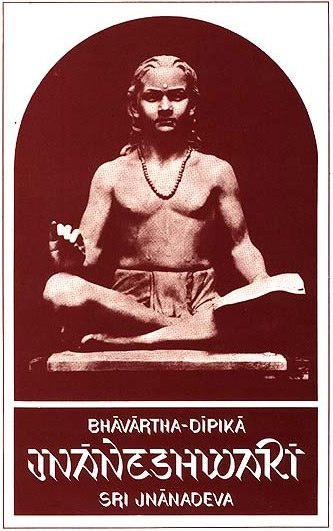Jnaneshwari (Bhavartha Dipika)
by Ramchandra Keshav Bhagwat | 1954 | 284,137 words | ISBN-10: 8185208123 | ISBN-13: 9788185208121
This is verse 15.7 of the Jnaneshwari (Bhavartha-Dipika), the English translation of 13th-century Marathi commentary on the Bhagavad-Gita.—The Dnyaneshwari (Jnaneshwari) brings to light the deeper meaning of the Gita which represents the essence of the Vedic Religion. This is verse 7 of the chapter called Purusottama-yoga.
Verse 15.7
Verse 15.7: “Of mine own Self a portion—ever enduring—it is which, in the world of the living, has transformed itself into the Individual Soul. He draws (in his service) the Senses (five) with the Mind for the sixth, which inhere in the Prakriti. (343)
Commentary called Jnaneshwari by Jnaneshwar:
When in this way, the knowledge of the Self gets limited to the bodyform, then it is perceived as a portion of my own self on account of its minuteness. Through a breeze the sea appears to be full of ripples and it is felt on account of narrow thinking that the ripples are a portion of the sea. In that way as a giver of life to the senseless and dull (matter) as also the creator of egoism in the body I appear, in the world of the living, as the individual soul (in the body itself), Oh son of Pandu. The activity that appears going on round about, to the limited discerning power of the living being, is called the world of the living.
To take birth and die—to consider these as real is what I call the world of the living or the mundane existence. You should view me in this world of the living, as the Moon (as reflected) in water even though the Moon is outside the water, or as a crystal placed on red turmeric powder, Oh, son of Pandu, which to ordinary vision appears red even though it is not itself red. In that way, it is an illusion that I appear as a doer or experiencer, even though the state of my being beginningless and a non-doer remains unaffected. Apparently, the pure soul getting united with the Prakriti, himself starts this flow in the form of the functioning of Prakriti. Then taking the six senses—mind and others, as also the sense of hearing and others—Prakriti’s products as his own, he, (the Soul) begins worldly dealings.
As an ascetic should in a dream himself become his own family and then should run about in his anxiety for the family and also out of greed; in that way the soul forgets its self, and taking itself as Prakriti it dances attendance on her. It then rides a chariot in the form of mind, passes out through the ears and enters into the wood in the form of speech. It then holds the strings of Prakriti, and turns in the direction of the skin and enters the wild forest in the form of touch-sense. At times, it enters the doors of the eyes and from there wanders astray on the mountain in the form of the objects of vision; or (sometimes) entering into the field of taste, Oh Warrior, it squeezes (himself) into the glen of the objects of taste. Similarly when this (egoistic soul) body-holder enters the doors of the nose, it wades through the jungle of fragrance. In that way making contact with the mind, it enjoys the Group of Sense-objects.
